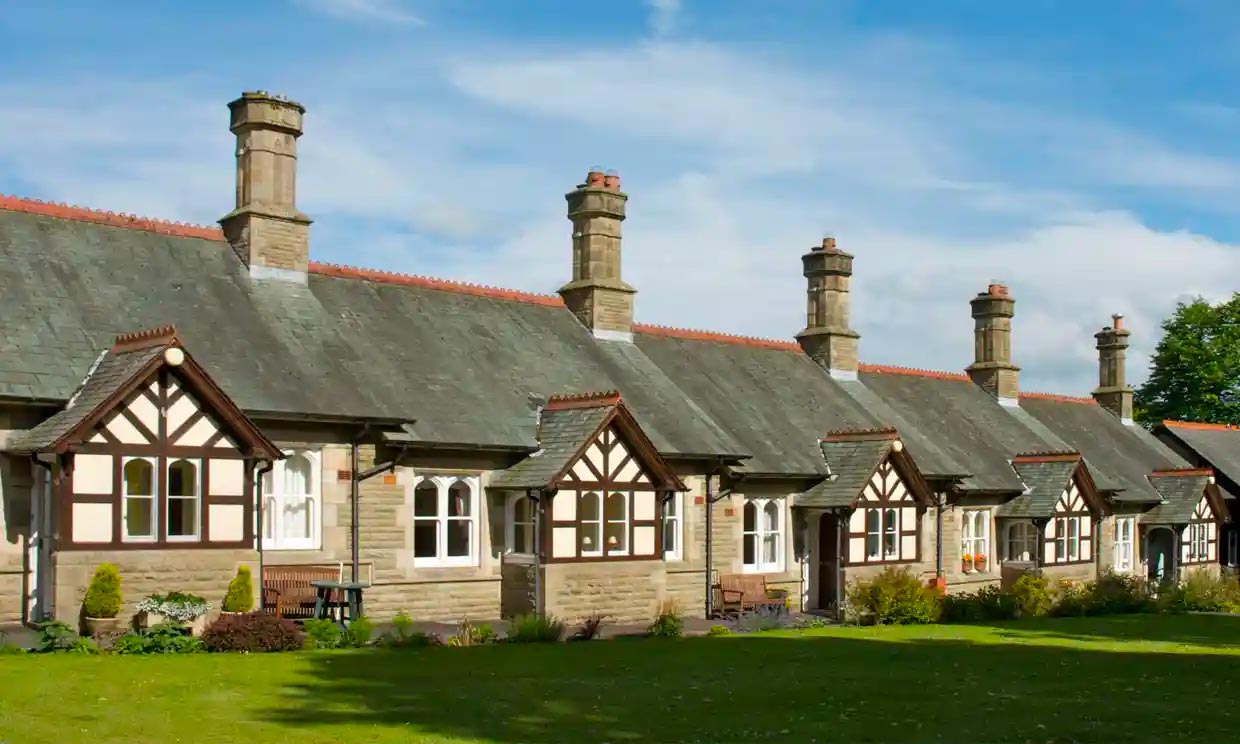Almshouse residents may live up to two and a half years longer, study finds
Co-author says UK’s oldest form of social housing could be part of solution to care crisis

Almshouses in the village of Waddington, Lancashire. The UK has 30,000 almshouses. Photograph: John Morrison/Alamy
Poor, older people living in almshouses enjoy longer lives than far wealthier people living elsewhere, a study has found.
The secret to longer life has been intensely sought after for centuries. But research using data from almshouses going back 100 years has found that the solution devised in early medieval times to help poverty-stricken knights returning from the Crusades is still relevant today.
The report from the Bayes Business School says the longevity of those who move into one of the UK’s 30,000 almshouses – the oldest form of social housing – is boosted by as much as two and a half years.
Given that residents typically move into almshouses in their early 70s, this is equivalent to an extra 15% of future life.
“Almshouses seem to wipe away the negative impacts on health and social wellbeing commonly experienced by older people in lower socioeconomic groups, particularly those living in isolation,” said Ben Rickayzen, a professor of actuarial science at Bayes and co-author of the Almshouse Longevity Study.
Almshouses are a charitable form of self-sufficient, low-cost community housing held in trust for local people in housing need. They are managed and run by almshouse charities made up of local volunteers.
Residents pay rent, usually called a maintenance contribution, which is often less than the average rent in local properties rented from a council, housing association or private landlord.
The best-performing almshouses in the study, Charterhouse and Morden College, bestowed a longevity boost on residents equivalent to that enjoyed by those in the second highest socioeconomic quintile.
It was a remarkable outcome, said Rickayzen, equating to a 73-year-old man receiving a longevity boost of 2.4 years – an extra 15% of future lifetime – compared with his peers from the same socioeconomic group, and 0.7 years when compared with an average 73-year-old from the general population.
“It is well known that the lower a person’s socioeconomic status, the lower their life expectancy. But our research has found that this doesn’t have to be the case,” he said. “We found that residents can expect to live as long as wealthier members of the general population despite coming from the most deprived quintile.”
Rickayzen said the study, which was sponsored by the Dunhill Medical Trust and the Justham Trust, and supported by the Almshouse Association, proved that this ancient form of housing still addressed the evolving needs of older people living in modern-day society.
Almshouses usually encourage residents to take part in social activities and have responsibilities for fellow residents, increasing their sense of belonging, giving them a greater sense of purpose and reducing isolation.
Alison Benzimra, a co-author of the report and the head of research at United St Saviour’s Charity, said the findings could help the government with its aim to reduce inequalities in mortality and provide a solution to the UK’s social care problems.
“This is an opportunity to improve the government’s levelling up agenda by incorporating the best features of communal living into their social housing policy,” she said. “It is important that levelling up should aim to combat health inequalities experienced by people from lower socioeconomic groups across the country.”
Nick Phillips, the chief executive of the Almshouse Association, said the findings could be replicated across all sections of society currently experiencing housing crises.
“The almshouse model is perfect not just for poorer, older people but young families, young people struggling to afford their first home and refugees,” he said. “It’s the housing model of the past but perfectly adaptable to the housing crises of not just today but the future too. We just need philanthropists to set up more of them.”